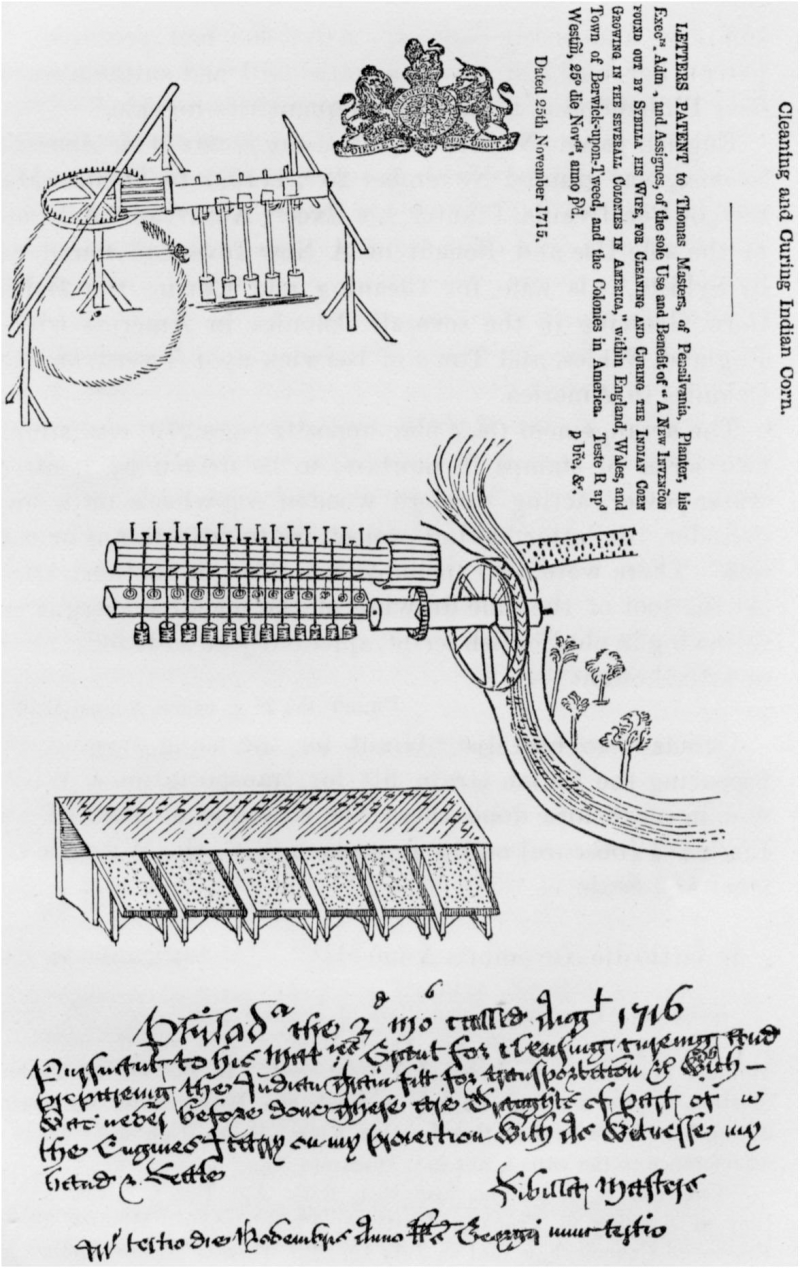Background
Sybilla Righton Masters lived in a prosperous household in Philadelphia in the early 1700s. In her free time, she explored ideas on how to improve life in the colonies. After watching how Indigenous women pounded corn with a mortar and pestle, Sybilla invented a corn gin that could do the same work with less human effort. In 1712 Sybilla sailed to London to get a patent for her invention. A patent is a document issued by the government that gives a person full rights over their invention.
Sybilla could not apply for the patent in her own name because of the English practice of coverture, so she submitted it in her husband’s name. Her husband was proud of her work and supportive of her efforts. He insisted that she be listed as the true inventor in the government records. If he had not, her story would be lost to history. Sybilla was the only known woman in the colonies to receive a patent from the English government.
About the Image
This illustration is the drawing Sybilla Righton Masters submitted to receive her patent for the corn gin in 1715. The first two pictures show different designs for the sheller. The sheller pounds the corn until it is turned into meal. The top design is powered by an animal (probably a donkey), and the second is powered by running water. At the bottom is her drawing of her design to bake the resulting corn meal in wooden trays.
Vocabulary
- coverture: A common law practice where women fell under the legal and economic oversight of their husbands upon marriage.
- gin: A machine that separates seeds from plants.
- patent: A government-issued license giving someone sole rights to their invention.
- sheller: The part of the machine that removed the shells from the corn seeds.
Discussion Questions
- Why did Sybilla Masters want a patent for her invention?
- What does this invention’s design and purpose reveal about life in the English colonies?
- Why did Sybilla Masters need to submit her patent under her husband’s name? How do we know about her? What does this reveal about the challenges of studying the history of women in the English colonies?
Suggested Activities
- APUSH Connection: 2.7 Colonial Society and Culture
- Use this resource in a lesson about inventions in the colonial era. This patent highlights how women contributed to innovation to make life in the colonies easier and more profitable.
- Lesson Plan: In this lesson designed for seventh grade, students will learn about industrialization and consider how new technology changed urban environments and altered people’s way of life. They will use Sybilla Masters’s patent as an example of changing technologies.
- Ask students to build a cardboard model of Sybilla Masters’s corn gin and label each piece with its name and function.
- Pair this resource with Mortar and Pestle for Pounding Rice and Indigenous Agricultural Innovation to consider the contributions of women to agriculture.
- Teach this document along with The Last Will and Testament of Joseph Grover for a more holistic picture of how coverture practices inhibited women in the English colonies.
- Sybilla Masters was one of many women in Europe and the Americas who made important contributions during the Enlightenment. Combine her story with the following resources for a lesson about women and the Enlightenment in the New World:
- Sybilla Masters saw a problem and designed a way to solve it. Use her story to inspire your students to do the same. You can explore invention projects and prompts for students at the Smithsonian’s Kid Inventors website.
Themes
SCIENCE, TECHNOLOGY, AND MEDICINE; WORK, LABOR, AND ECONOMY
New-York Historical Society Curriculum Library Connections
- For more resources relating to the practice of coverture, see Saving Washington: The New Republic and Early Reformers.







